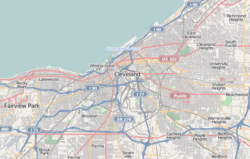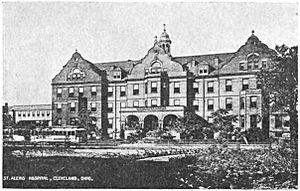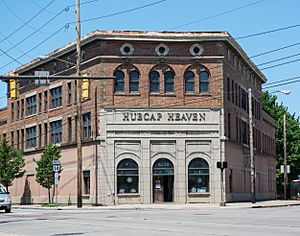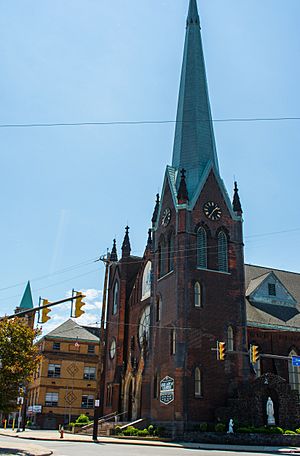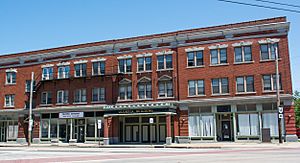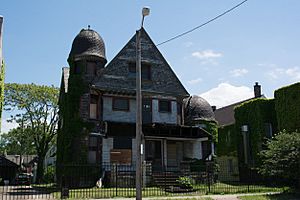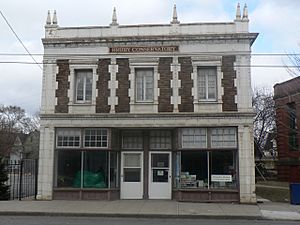Broadway Avenue Historic District (Cleveland, Ohio) facts for kids
Quick facts for kids |
|
|
Broadway Avenue Historic District
|
|
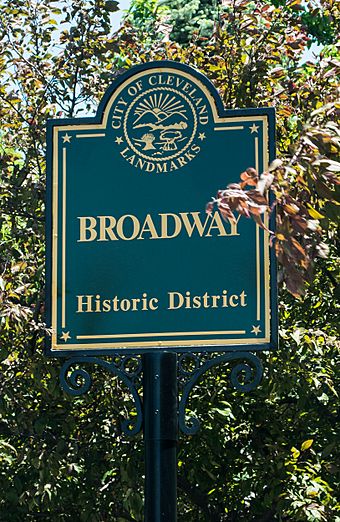
Sign marking an entrance to the historic district
|
|
| Location | Broadway Avenue between Barkwill Avenue and Cable Avenue; E. 55th Street from Lufkin Avenue to Broadway Avenue; Cleveland, Ohio |
|---|---|
| Area | 8 acres (3.2 ha) |
| Architectural style | Early Commercial, Italianate, Jacobean Revival, Neoclassical, Queen Anne, Renaissance Revival |
| NRHP reference No. | 88001860 |
| Added to NRHP | October 19, 1988 |
The Broadway Avenue Historic District is a special area in the Broadway–Slavic Village neighborhood of Cleveland, Ohio. It's known for its historic shops and buildings. This district was once the main gathering place for Cleveland's Czech community. It's a great example of how a neighborhood can grow and change around a streetcar line.
The district includes 43 buildings that were built between 1888 and 1930. Some famous buildings here are the Hruby Conservatory of Music and Our Lady of Lourdes Church and School. This important commercial area was added to the National Register of Historic Places on October 19, 1988.
Contents
How the District Began
Long ago, in 1795, a group called the Connecticut Land Company bought a large area of land in Ohio. This land was known as the Connecticut Western Reserve. In 1811, a man named Youngs L. Morgan, Sr., bought 100 acres of this land. This land is now around E. 55th Street and Broadway Avenue. He and his family farmed this land for many years. Other families also owned farms nearby.
In the early 1800s, people started building taverns (like inns or restaurants) in the area. These places were important stops for travelers. Later, in the 1840s, the Cleveland and Pittsburgh Railroad was built. This railroad helped new businesses and factories grow along Broadway Avenue. One important company was Grasselli Chemical, started in 1856.
Early Czech Communities in Cleveland
Many Czechs began moving to the United States in the 1850s. While some planned to move further west, many decided to stay in Cleveland. Soon, Cleveland had one of the largest Czech populations in the country.
The first Czech neighborhoods in Cleveland were near the Cuyahoga River. Many Czech immigrants had been farmers in their home country. A Cleveland farmer named Harvey Rice helped them buy land at good prices. Over time, a large Czech community grew around E. 37th Street and Croton Avenue. The first Catholic church for the Czech community, St. Wenceslas Church, was built in 1867.
In the 1870s, John D. Rockefeller started the Standard Oil company in Cleveland. This company needed many workers to make wooden barrels for oil. Many Czech Americans became barrel makers for Standard Oil. This brought even more Czech families to the Croton area. The first public school in the North Broadway area, Warren School, opened in 1871.
Creating the Broadway District
Several things helped the Czech community grow south of the Croton neighborhood, leading to the Broadway commercial district.
- First, large farms were divided into smaller, more affordable plots for homes starting in 1878.
- Second, new bridges were built over Kingsbury Run, making it easier to travel north and south. This allowed workers to live in less crowded areas but still get to their jobs.
- Third, the growing Standard Oil refineries caused noise and pollution. This encouraged people to move to quieter neighborhoods further away.
- Fourth, a new wave of Czech immigrants arrived in Cleveland starting in 1870. They needed homes and land.
The first new Czech settlement south of Kingsbury Run was at Trumbull Avenue and E. 37th Street. This area was called Na Vrsku (On the Hill). In 1892, St. Wenceslas Church started building a new church nearby. As more Czech Americans moved in, businesses and homes spread south along Broadway Avenue. Many new homes were small cottages with gardens, a tradition Czech immigrants brought with them. New streets were even given Czech names.
Bohemian National Hall, a community center, was built in 1897. Banks, churches, and shops soon followed along Broadway Avenue. By 1900, the intersection of E. 55th and Broadway became the main center of the new Czech community.
History of the Broadway Historic District
The commercial district on Broadway Avenue was known as Žižkov. It stretched from E. 37th Street to Union Avenue.
Growth: 1870 to 1900
The late 1800s saw many important buildings added to the area.
- In 1872, Broadway Methodist Church was built. By 1920, it was a very large and wealthy non-Catholic Czech church. It even has a life-size copy of Leonardo da Vinci's The Last Supper painting.
- The first public school in the area, South School (later Barkwill School), opened in 1875.
- In 1880, the Joseph Turner & Sons Manufacturing Company opened a woolen mill, helping to define the southern edge of the district.
The 1880s brought more services and businesses.
- Police Station No. 4 was built in 1883.
- The Fowler School, another public school, opened in 1883.
- Broadway Bank was established in 1883. It was one of the first banks in a suburban area in the United States. It became very successful, thanks to Czech American businesses.
- St. Alexis Hospital opened in 1884. It was only the second Catholic hospital in Cleveland. In 1906, the world's first human-to-human blood transfusion happened there.
- The Canfield Oil Company built a new refinery in 1887.
- St. Johannes Evangelical Lutheran Church was built in 1889.
The 1890s saw the building of Our Lady of Lourdes Church, a very important building in the neighborhood. The growing Czech American community needed a new church. Construction began in 1891. This beautiful Gothic Revival church became a central part of the community. It had many groups and societies for its members. Our Lady of Lourdes School opened next to the church in 1905. Over the years, more buildings were added to the church campus.
Other important things that happened in the 1890s include:
- Columbia Savings and Loan was established in 1891.
- Streetcar service began along Broadway in 1893, making travel easier.
- Vcela Savings and Loan was founded in 1896.
- The American, a daily Czech-language newspaper, started publishing in 1899. It became one of the largest non-English newspapers in Cleveland.
Peak Years: 1900 to 1930
The early 1900s were the best years for the Broadway Historic District. More Czech immigrants arrived, many of whom were well-educated. To meet the community's needs, the Cleveland Public Library opened the Broadway Branch Library in 1902. This building was unique because it had 10 sides!
By 1910, Cleveland had the largest Czech community in the United States. The Žižkov community was so big and important that people joked Cleveland might become the capital of the new country of Czechoslovakia.
In 1912, the Olympia Theatre opened. This large theater had 2,000 seats and was a mixed-use building. It also had shops on the first floor and apartments above.
World War I slowed down immigration, but the Broadway area continued to grow. By 1920, there were six banks in just two blocks around Broadway and E. 55th. New banks like Atlas Savings and Loan and Oul Building and Loan opened.
Probulov Hall, a Czech community meeting place, was built in 1915. In 1915, Czechs and Slovaks signed the Cleveland Agreement at Bohemian National Hall. This agreement helped lead to the creation of an independent Czechoslovakia after World War I.
Some of the last major buildings in the district were built in the early 1920s. These included Bethlehem Chapel, a church that opened in 1921. Tate Field, an athletic field, was created in 1921 for a professional baseball team. Later, it was renamed Hooper Field and hosted soccer games.
By the end of the 1920s, the Broadway commercial district was a busy place with many bakeries, banks, and shops. It was the largest shopping area outside of downtown Cleveland. The Czech and other Slavic communities had a huge impact on Cleveland's growth.
Changes: 1930s to 2000s
The Great Depression in the 1930s caused many businesses to struggle. However, Broadway Avenue remained an important shopping area into the 1940s. Third Federal Savings and Loan, founded in 1938, was one success story. It grew into a large company because of its careful lending.
After World War II, the area began to change. Many factories closed, and people moved to the suburbs. This caused the population in the Broadway district to drop significantly. Banks also became less willing to lend money for homes and businesses in the area, which made things harder.
Pollution from nearby steel factories also became a big problem. Heavy smoke and fumes damaged gardens and trees. This pollution also encouraged many residents to move away.
New highway construction also affected the area. In the 1950s and 1960s, new interstate highways were planned. Some old homes, businesses, and even St. Wenceslas Church had to be torn down to build these roads.
Our Lady of Lourdes High School closed in 1969. By the 1970s and 1980s, the Broadway shopping area continued to decline. The term "Slavic Village" was created to help promote the area, which included North Broadway and other Eastern European neighborhoods.
The Olympia Theatre closed in 1981. Later, parts of the building were renovated, but the theater itself was removed for parking.
Recent Years: 2000 to Present
In the 1990s, the Broadway retail district started to see some improvements, thanks to groups like Slavic Village Development.
St. Alexis Hospital was a major part of the community. It had grown over the years to include a nursing school and other medical facilities. However, the hospital faced financial problems and eventually closed in 2003. The city bought the hospital campus and tore down the buildings in 2007.
Around 2005-2006, many unfair loans were given out in the Slavic Village area. When people couldn't pay back these loans, they lost their homes. This led to the area being called the "epicenter of the Great Recession." The financial crisis caused the population to drop even more.
In 2010, Broadway United Methodist Church closed. The population of North Broadway continued to decline, but many African American families moved in because housing was very affordable. This changed the neighborhood's population mix.
Despite these challenges, the heart of Cleveland's Czech community remained centered on E. 55th Street and Broadway Avenue into the 21st century. It is still a well-known and important part of Cleveland's history.
About the Historic District
The Broadway Historic District was added to the National Register of Historic Places on October 19, 1988. It includes buildings on Broadway Avenue (between Cable Avenue and Barkwill Avenue) and E. 55th Street (between Lufkin Avenue and Broadway Avenue).
The district has 43 commercial buildings built between 1888 and 1930. It also includes Our Lady of Lourdes Church and Our Lady of Lourdes School. The buildings show different architectural styles, such as Early Commercial, Italianate, Neoclassical, Queen Anne, Renaissance Revival, and Jacobean Revival. Most buildings are one to six stories tall and are built right up to the sidewalk.
Some of the important buildings in the historic district are:
- Broadway Branch, Cleveland Public Library (built 1902; Neoclassical style)
- Federman Building (built 1907)
- Hruby Conservatory of Music (built 1912; Jacobean Revival style)
- Melzer Building (built 1909)
- Olympia Theatre (built 1912)
- Our Lady of Lourdes Church (built 1891; Gothic Revival style)
- Our Lady of Lourdes School (built 1906; Renaissance Revival style)
- Zverina Block (built 1889; Eastlake movement of the Queen Anne Style)
The Broadway Historic District was named a Cleveland Landmark in November 1990. It is part of Cleveland's Broadway-Slavic Village area, with Broadway Avenue at its center.
Images for kids


